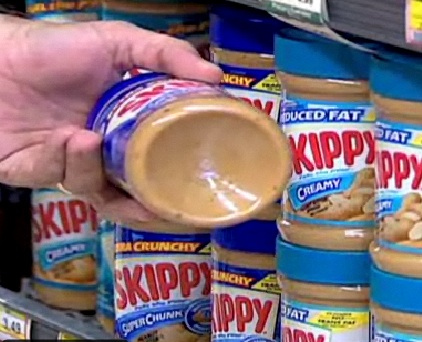Submitted by Anne Landman on
 Prices of your favorite grocery items are skyrocketing, but you probably don't know it. Many companies are using a sneaky way to raise prices without driving customers to less expensive brands: they are shrinking their packaging. A jar of Skippy peanut butter, for example, is the same height and circumference it has always been, but now has a hidden, inward "dimple" on the bottom that decreases the amount the jar holds by two ounces. Boxes of breakfast cereal appear to be the same height and width they've always been, but manufacturers have reduced the boxes' depth from front to back, decreasing the amount of cereal they hold. Rolls of Scott toilet tissue contain the same number of sheets as always (1,000), but the length of each sheet has been cut from 4 to 3.7 inches. A "six ounce" can of Starkist Tuna now holds just five ounces. When asked about the shrinkage, most companies point to higher costs for ingredients, manufacturing and fuel. Dan Howard, a marketing professor at Southern Methodist University, says the only way consumers can fight back against this sneaky way of increasing costs is to refuse to buy from manufacturers who engage in this deceptive tactic.
Prices of your favorite grocery items are skyrocketing, but you probably don't know it. Many companies are using a sneaky way to raise prices without driving customers to less expensive brands: they are shrinking their packaging. A jar of Skippy peanut butter, for example, is the same height and circumference it has always been, but now has a hidden, inward "dimple" on the bottom that decreases the amount the jar holds by two ounces. Boxes of breakfast cereal appear to be the same height and width they've always been, but manufacturers have reduced the boxes' depth from front to back, decreasing the amount of cereal they hold. Rolls of Scott toilet tissue contain the same number of sheets as always (1,000), but the length of each sheet has been cut from 4 to 3.7 inches. A "six ounce" can of Starkist Tuna now holds just five ounces. When asked about the shrinkage, most companies point to higher costs for ingredients, manufacturing and fuel. Dan Howard, a marketing professor at Southern Methodist University, says the only way consumers can fight back against this sneaky way of increasing costs is to refuse to buy from manufacturers who engage in this deceptive tactic.

Comments
Anonymous replied on Permalink
This has been going on for years
This started happening back in the 70's. How about McDonalds? The prices are now starting to increase but. the packaging was getting smaller just about on a yearly basis. The 1/4 pounder used to be bigger, as well as the pies, and I know everyone has noticed the fries, not to mention the coffee's
Anonymous replied on Permalink
Read the price labels closely
I doubt "every" store does it, but almost every one I shop at has the cost/oz on the price tag. That part can't lie.
James1094 replied on Permalink
price per unit
As far as I know, this is required by law. It's in tiny numbers though and a shocking number of people don't understand this simple concept. You can bet nobody would list it if not required though, and it doesn't make me feel any less cheated when I have to read the fine print to discover the package is smaller.
OjnoTheRed replied on Permalink
I'm shocked - no, really I am. Sorry if I sound sarcastic.
... and I thought they were shrinking portion sizes without lowering the price for the sake of our health.
Mars actually tried using that one on the public - years after introducing a "King Size" bar which they naturally charged more for than 'regular sized'.
A good point, though, PR Watch - well said.
Anonymous replied on Permalink
In the UK many supermarkets
In the UK many supermarkets have price tickets on the shelf that show price per 100g of the product (or price per litre). It's written smaller than the headline price, but it's clearly legible. Makes getting away with packet shrinkage much harder. It also shows any saving you might get from buying a bigger packet rather than smaller ones..
Anonymous replied on Permalink
We have that in the US too...
...but people don't read. Or they don't understand simple fractions.
Anonymous replied on Permalink
Watery Dog Food
Texas supermarket chain HEB has found an even sneakier way to raise prices. Their store brand canned dog food is still 22 ounces per can, but they've greatly increased the water content. It now looks more like dog soup than dog food.
David in Brooklyn replied on Permalink
Science Diet did a similar
Science Diet did a similar watery dilution a few years ago with canned cat food. Flavors went from chunky/crumbly to stewy/splattery. I changed brands because of the messiness. (Why couldn't they just raise prices? It's supposed to be a premium brand. Why would I want to haul home water?)
JenniferK replied on Permalink
Science Diet...
...is a waste of money anyway. For years Hill's (the makers of SD) was the main source of nutrition education at many American veterinary schools. No wonder so many veterinarians promoted their products. Do some research and start reading labels - your cat will thank you for it. Try for a start http://www.petfoodratings.net/cattable.html.
bb replied on Permalink
buyer beware
they're putting the new weight on all of the packages, so why is it their fault? the skippy peanut butter jars show on the labelling that they are 2 ounces less than usual.
Pages